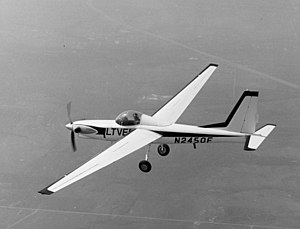LTV L450F

| L450F | |
|---|---|
 | |
| Role | Reconnaissance aircraft |
| Manufacturer | Ling-Temco-Vought |
| First flight | February 1970 |
| Primary user | United States Air Force |
| Developed from | Schweizer SGS 2-32 |
| Developed into | LTV XQM-93 |
The LTV L450F, also known as the L45ØF,[1] was a prototype quiet reconnaissance aircraft, developed by Ling-Temco-Vought in the late 1960s for use in the Vietnam War by the United States. Based on the airframe of a Schweizer 2-32 sailplane, the aircraft flew in 1970, and was developed into the XQM-93 reconnaissance drone before the project was cancelled.
Design and development
[edit]Developed as a follow on to the Igloo White program, the L450F was intended to provide a quiet reconnaissance and communications relay aircraft.[1] Under a $1 million USD contract by LTV Electrosystems, the L450F was developed from a Schweizer SGS 2-32 sailplane, modified by Schweizer to LTV's specifications.[1]
These modifications included stronger wing spars, thicker wing skin, installation of a Pratt & Whitney PT6A turboprop engine driving a three-bladed propeller, and main landing gear based on that of the Grumman Ag-Cat agricultural aircraft.[1] An alternative configuration, using a piston engine, was also proposed.[1]
The prototype L450F first flew in February 1970, but was destroyed during its third flight, on 23 March that year, the pilot successfully bailing out. A second prototype was then completed and flown, successfully completing the testing program, and a third prototype was ordered as the unmanned XQM-93 drone, under the Compass Dwell project. Four examples of the XQM-93 were contracted for by the United States Air Force, however the Compass Dwell project was subsequently cancelled.[1][2]
Operational history
[edit]
27 March 1972 Donald R. Wilson reached the altitude of 15,456 m (50,708 ft) in horizontal flight flying the remaining L450F, registered N2450F, setting a new Fédération Aéronautique Internationale international record, Class C-1c, Group II[3] (Powered aeroplanes, takeoff weight 1000 to 1750 kg, turboprop). This record still stood as of 27 March 2012.
Specifications (prototype)
[edit]Data from Janes[1]
General characteristics
- Crew: 1 (pilot)
- Length: 29 ft (8.8 m)
- Wingspan: 57 ft (17 m)
- Empty weight: 2,400 lb (1,089 kg)
- Max takeoff weight: 4,600 lb (2,087 kg)
- Fuel capacity: 2,300 pounds (1,000 kg)
- Powerplant: 1 × Pratt & Whitney PT6A-29 , 778 shp (580 kW)
- Propellers: 3-bladed Hartzell
Performance
- Cruise speed: 105 mph (169 km/h, 91 kn)
- Range: 6,000 mi (9,650 km, 5,210 nmi)
- Endurance: 24–30 hours
- Service ceiling: 52,000 ft (16,000 m)
- Maximum glide ratio: 28:1
- Rate of climb: 2,600 ft/min (13 m/s)
See also
[edit]Related development
Aircraft of comparable role, configuration, and era
Related lists
References
[edit]Notes
[edit]- ^ a b c d e f g Jane's 1971, p. 344-345
- ^ Goebel, Greg. "The Prehistory of Endurance UAVs" Archived 30 July 2013 at the Wayback Machine. VectorSite. Accessed 18 June 2010.
- ^ "Fai Record File". Fai.org. Retrieved 5 May 2012.
Bibliography
[edit]- Taylor, John W.R. (ed.) Jane's All The World's Aircraft 1971–1972. London: Sampson Low Marston & Co, 1971. ISBN 0 354-000-942.
External links
[edit]![]() Media related to LTV L450F at Wikimedia Commons
Media related to LTV L450F at Wikimedia Commons